#Abbot represents
Quote
Today's Christians: dropping 2 buss loads of people off in an unfamiliar place in 18 degree temperature without any support.
12/24/2022
#Christianity#Christian#Jesus Christ#christians#lack of empathy#immoral#don't be like Christians#Bible#evangelicals#GOP#republican#shameful#Abbot represents#christians support#evil
8 notes
·
View notes
Text
Today is All Saints Day, and I'm observing it in a somewhat unconventional manner: cyberbullying the Anglican Church in North America
The ACNA, if you're not familiar, is a group that splintered off from the Episcopal Church in 2009. The reason for the schism was that they believed TEC had "gone astray" by ordaining women priests and affirming LGBTQ people, so a bunch of conservative Episcopalians and clergy split off into their own group: the ACNA. They claim to be "continuing" Anglicans, representing the "real" Anglican tradition in the US and Canada.
The reason I'm cyberbullying them on All Saints Day is because they are conspicuously missing a lovely, pious, respectable, and orthodox Anglican saint: Saint Aelred of Rievaulx (1110-1167 CE)
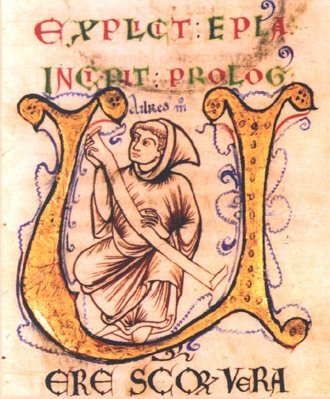
St. Aelred was a monk, abbot, historian, and spiritual writer from Northumbria. During his lifetime, the abbey boasted hundreds of monks and lay brothers, because Aelred was known for his friendly and gentle demeanor, wise leadership, and healthy community. He had the ear of kings and bishops all over northern Europe. He preached charity, humility, chastity, and all kinds of other Christian virtues. In short, he was the very model of a respectable medieval churchman.
He was also Very Much In Love With Men, and he wrote a treatise called "Spiritual Friendship," which might be nicknamed "How To Be In Love With Men In A God-Honoring Way." I've read it. It's wonderful and timeless and also very, very gay. He was in love with men. In a gay way.
Fast forward to the year 1980. Up until this point, St. Aelred had been a somewhat obscure local English saint. And then a groundbreaking new book was published which challenged all conventional narratives surrounding the Church and queer people in the Middle Ages: Christianity, Social Tolerance and Homosexuality by John Boswell. Boswell wrote at some length about Aelred and his love for men, drawing on his other work besides "Spiritual Friendship" and situating him into what was actually something of a "golden age" of gay culture in western Europe. Yes, really.
Fast forward again to the year 1985. At the Episcopal Church's general convention that year, members of Integrity USA (the original LGBTQ advocacy org in TEC) campaigned to have St. Aelred added to the calendar of saints. The House of Bishops agreed, and they added him to the church calendar with full knowledge that Aelred was gay.
Aelred was also physically disabled, and he wrote about his Spiritual Friend becoming "my hand, my eye, the staff of my old age": in other words, his Spiritual Friend was his caretaker as his health declined near the end of his life (which was still quite short even for a medieval person). He also describes the pain of his Spiritual Friend's early death in a way that remains tender 800 years later. I will leave you to imagine why that might be spiritually relevant to a bunch of nice church gays in 1985.
Fast forward again to 2009. The conservative wing of the Church has had enough of TEC's bleeding-heart liberal reforms, so they secede from the union leave and establish their own church without any icky queers or women priests. St. Aelred had been an official Episcopal saint for 25 years at that point, and the newly-formed ACNA had to consciously, deliberately choose to remove him from their calendar of saints.
Fast forward again to earlier this summer. I start doing research into queer Christian history and queer saints. I realize that Aelred is conspicuously missing from the ACNA's calendar, so I look into the background and decide to get obnoxious about it on Instagram. Because this is VERY embarrassing for a church that claims to be the "real" Anglican Church in North America.
A selection of memes for your enjoyment:
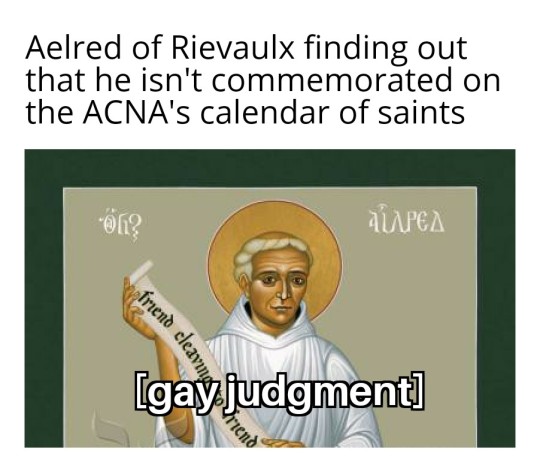



338 notes
·
View notes
Text
Regarding this post.
I think I did come to a conclusion regarding this whole bishop!Aziraphale mess.
There could be a thousand reasons, why he was a bishop. Could be curiosity in human religion, could be his roleplay hobby showing, could be for a mission and so on. I don't think he was lying here. As far as we know, Aziraphale takes his jobs very seriously. He wouldn't do anything half-heartedly (for example: learning french the hard way or insisting to take a driving test, although he doesn't need one).
My personal hc is, that it was a disguise for a mission.
But let me explain.
So Neil did mention a scrapped “15th century papal” minisode for S2. This could refer to a lot of things of course. For my hc I'm choosing the following event.
At the beginning of the 15th century there was a split within the catholic church, also known as the Papal Schism. Long story short, there where three rival popes (Pope Gregory XII in Rome, Pope Benedict XIII in Avignon and Pope John XXIII in Pisa), who claimed to be the rightful head of the catholic church. The increasing secularization of the church in general was a problem too.
So to unite the catholic church again, a council was held (also known as the Council of Constance) to decide, which pope was the rightful one. The whole council was a single chaotic mess. The only pope, who showed up, secrectly fled again and was later put in jail. The other two didn't even appear and also disqualified themselves so to speak. Finally in 1417, three years after the council started, the joint Pope Martin V. was elected, which ended the schism.
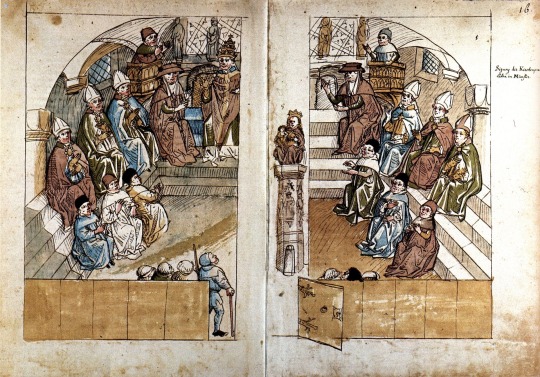
Just some bishops and cardinals chilling together, debating with Pope John XXIII.
Anyway my point is, the council was attended by a large number of cardinals, abbots, bishops and archbishops from different nations, such as England, Germany, France, Italy, Poland, Hungary, Scandinavia, etc. One can imagine the council as some kind of medieval Wacken, the biggest party at this time with emperors, nobles, peasents, handyman, merchants and generally thousands of people from all around the world, who gathered in the small city of Constance.
It would be easy for a certain angel to dive in the mass and disguise as a bishop. Why? Maybe he got a strong word from Up ("Hey Aziraphale, what's going on with Gods representative on earth? Humans make a mockery of Her ineffability!" "Um, it gotten a bit out of hand, yeah." "Sort this out immediately!" "As you wish...")
So Aziraphale thought of a plan and attended the council as a bishop to make sure that this time a righteous person would be chosen as Pope. After the election though he was quick to get rid of his regalia. Human religion didn't fit what he envisioned and he decided that angels shouldn't meddle with it.
151 notes
·
View notes
Text
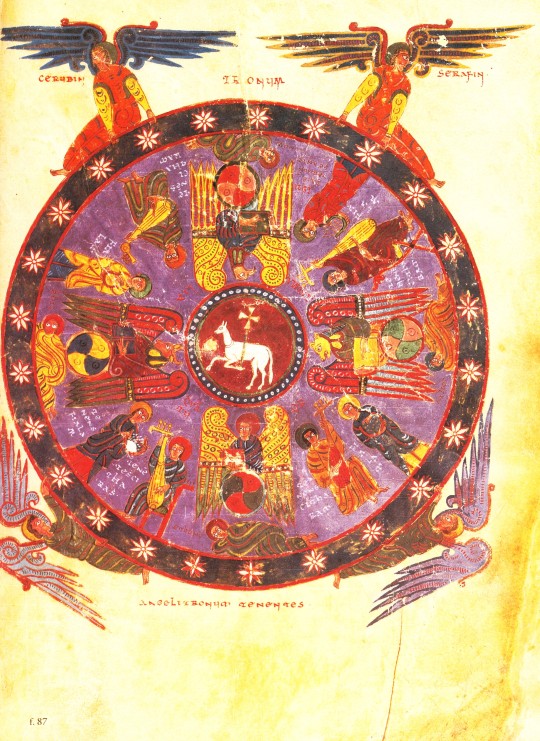

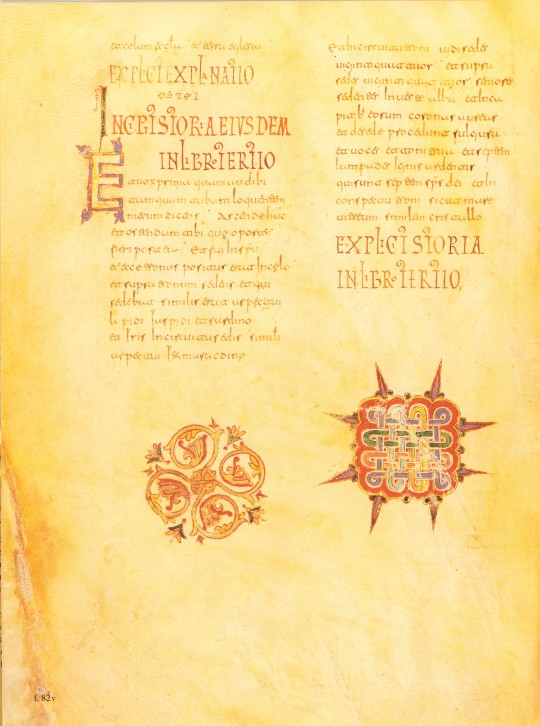
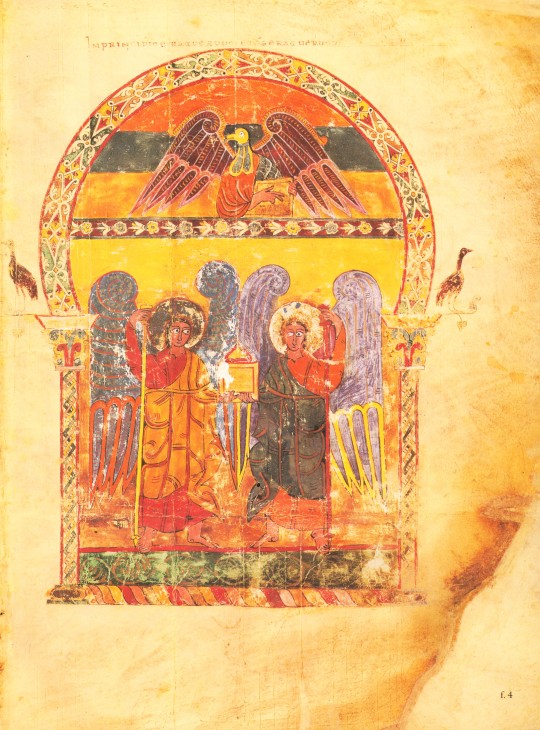




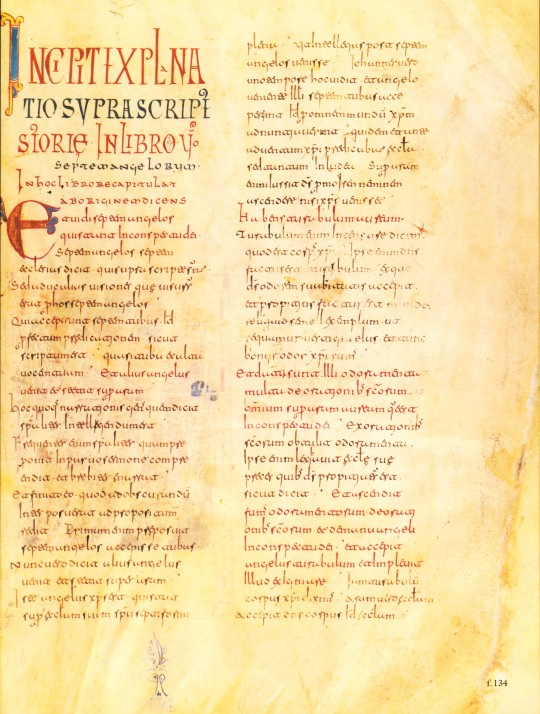
Welcome to Manuscript Monday!
In this series we will periodically focus on selections from our manuscript facsimile collection. Today we present selections from the Morgan Beatus Manuscript, reproduced as A Spanish Apocalypse, The Morgan Beatus Manuscript in New York by George Braziller, Inc. in association with the Pierpont Morgan Library in 1991. The original manuscript, made around 10th century CE at the scriptorium of San Miguel de Escalada in Spain by a monk named Maius, is the earliest surviving illuminated version of the monk Beatus of Liébana's commentary on the biblical Book of Apocalypse (also known as the Book of Revelation). The text of the Book of Revelation makes up the first part of the manuscript, and Beatus’s commentary comprises the second part. The Book of Revelation tells of the end-times in Christianity, during the final judgement of humanity by God. The story within this Biblical book was also seen by those living during the Latin medieval era as representative of the beginning of something new: God’s celestial kingdom. Due to this view of the book, many artists incorporated imagery from this part of the Bible in their work.
Produced in Al-Andalus, or Muslim-ruled Spain, the artistic style of this work combines both Muslim and Christian visual traditions to create a beautifully illuminated manuscript that supplements the commentary by the monk. This artistic style is known as the Mozarabic, which comes from the Arabic mustaʿrib, meaning ‘Arabicized’. Interestingly, this style of art can only be seen in Christian religious art and architecture from Spain at the time, as non-religious artistic objects made by Christians look so similar to Islamic versions of the same works that they cannot be identified as intentionally Christian. Some key Islamic artistic elements within the manuscript include buildings with horseshoe arches, intricate geometric and vegetal patterns as borders for larger images, and the large, bulging eyes of the illustrated animals.
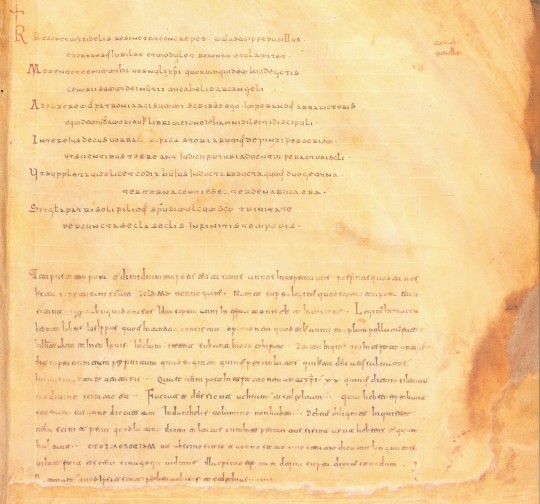
Another interesting aspect of this specific manuscript is the colophon at the end of the manuscript. It tells readers about the circumstances surrounding the creation of this book, including the maker, the patron, the year it was made, and an explanation about why Maius created the manuscript ("I write this . . . at the command of Abbot Victor, out of love for the book of the vision of John the beloved disciple. As part of its adornment I have painted a series of pictures . . . so that the wise may fear the coming of the future judgement of the world's end."). Colophons in medieval manuscripts are not usually as detailed, so the inclusion of all this information contributes greatly to the knowledge and history surrounding the Morgan Beatus Manuscript.
View more Manuscript Monday posts.
– Sarah S., Special Collections Graduate Intern
#manuscript monday#manuscripts#morgan library#morgan beatus manuscript#Beatus of Liébana#Spain#Christian art#Mozarabic#Islamic art style#facsimilies#Spanish art#Medieval art#Spanish medieval art#A Spanish Apocalypse#George Braziller#illuminated manuscripts#Sarah S.
138 notes
·
View notes
Text
My own for fun fleshing out of the idea posited by Jonathan Morris that the other voices Xoanon adopts in the Face of Evil are forgotten incarnations plucked from the Doctor's subconscious.
Specifically played by Pamela Salem, Rob Edwards, Anthony Frieze and Roy Herrick.
The First Xoanon Doctor (Pamela Salem)
This incarnation was posted on Earth by her request, as part of the Time Lords solidifying of the Web of Time as history, arriving in the era of the First World War. Upbeat and playful, she had a knack for outmanoeuvring her opponents even in spite of the cultural pushback against the form this incarnation took. She also often came across as anachronistic due to a lack of understanding of the culture of the era of this planet that she was assigned to. She, however, was occasionally prone to seeing humans more as interesting specimens than individuals in their own right.
The Second Xoanon Doctor (Rob Edwards)
Coming across as an eccentric but kindly Professor-like figure, wearing a scruffier version of a formal outfit. This incarnation took up teaching on Earth. He was heavily interested in the idea of luck as an external force and wore a clover on his lapel to represent that. He was prone to meddling in events outside his purview, but only subtly, within his remit as an agent of the Time Lords and thus often employed luck or what appeared to be luck as a ‘weapon’ of sorts in said situations, despite his pleasant exterior he was capable of doing almost anything if he thought it would benefit the ‘greater good’. He was the first incarnation to meet the Abbot.
The Third Xoanon Doctor (Anthony Frieze)
This incarnation lived for a long time, aging up from a child to an adult. He spent a lot of his time on Gallifrey, getting involved in the internal politics of the planet as an advocate for the Non-Intervention policy. He regretted the meddling his immediate predecessor was prone to, though he still returned to Earth to observe the planet and would occasionally intervene if he found a situation significant enough to warrant it. He was brash and abrasive, and had a superiority complex, but still was a kind-hearted person when the chips were down. He met his end in service to Gallifrey in the midst of a Time War.
The Fourth Xoanon Doctor (Roy Herrick)
A calmer, younger, mellower incarnation. This Doctor prided himself on his moral compass, whilst he still acted as an agent for the Time Lords, he treated the role as secondary to his interest in the planet Earth and its people. He was granted an official remit to travel across the Universe, rather than just the history of the planet he was observing, as a result of a great service to Gallifrey during his early life. He was also one of few early incarnations of the Doctor who contemplated any form of relationship with a human, though he ultimately never went through with it. Despite this, he still maintained a wide social network in the era to which he was assigned.
(Did an amateur artwork, also including headcanons for the 'eras' under the assumption of them directly preceding the Morbius Doctors from Forgotten Lives)
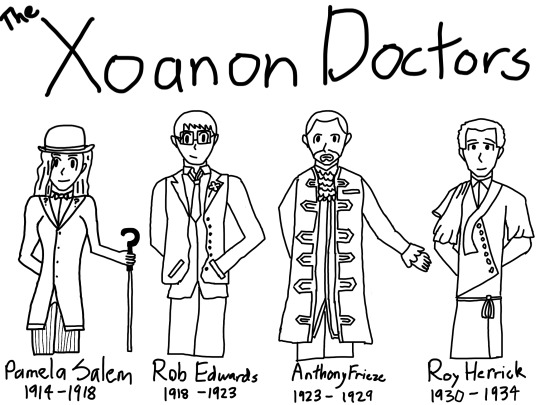
#doctor who#dweu#doctor who eu#forgottenlives#forgottenlivesobverse#morbius doctors#xoanon doctors#pamela salem#rob edwards#anthony frieze#roy herrick#obverse books
25 notes
·
View notes
Note
Do you think all of the S28 have crests/animals like how the Malfoys have their peacocks and the Averys have barn owls?
Yes, I do! Most of the Sacred Twenty Eight seem too stuck on their high horse to not have something like a crest/animals to represent them. I went with animals for this since I've got significantly more thoughts for that than on the crests, but I would imagine these also show up on some variant of a family crest as well. I got a bit of help from a friend with this one but,,, here are our thoughts lol
Abbot - Doves
The Old English derivative "abbod" is a reference to the head of monasteries and the Old French "abet" means "priest".
Avery - Barn Owls
Black - Black Ravens
This is canon, as seen on the Black family tree, but ravens are the specific corvus due to their symbolism.
Bulstrode - Marsh Frog
The Old English "bula" means "bull" and "strōd" means "overgrown marsh", yet bullfrogs are not native to the area.
Burke - Porcupines
Derives from the Norwegian name "Børke", which originated from the Old Norse "birki", meaning "birch forest", a location commonly populated by porcupines.
Carrow - Stoat
The Welsh surname "Caeriw" means "dweller at the fort on the hill", an area that stoats can be found. They are also a breed of mustelid that highly resemble a weasel, which highlights their Slytherin traits in reference to the phrase "weasel out of something", meaning to be cowardly.
Crouch - Lamb
The Old English term "crūc" means "cross", an item from a religion associated with lambs in direct correlation to their saviour.
I especially love this for the religious context and it symbolically means innocence, purity and sacrifice. Especially the latter works great with how Crouch Senior sacrifices his son for the sake of his career but also how Artemisia Crouch (Barty's mother) sacrifices herself for her son (who she believes to be innocent as far as we're aware), something that she would have never done if she had not married into the Crouch family.
Fawley - Hare
The names originate from the Old English terms "fealu", meaning "fallow", or "colour", "fealh", meaning "ploughed land", and "lēah", which means "woodland clearing". The hare is a woodland creature with earthy tones, suiting each origin.
Flint - Otter
The Old English name means "stream", an otter's habitat.
Gaunt - Serpent
The Middle English term meant "slender", an apt description of a snake and a reference for their status as Slytherin's heirs.
Greengrass - Red Deer
An animal that takes residence in grassy areas.
Lestrange - Fox
The name derived from "foreigner" in French, which leads one to believe that they were perceived as outcasts, presumably to the Muggle world, as would likely be subsequently associated with the occult, of which foxes are part. Traits symbolised by the animal also follow Slytherin's creed.
Longbottom - Hedgehog
The Old English words "lang" and "botm" mean "valley bottom", where hedgehogs may be found.
Macmillan - Lion
Often depicted on the Macmillan family crests.
Malfoy - Albino Peacocks
This is once again another canon one. Lucius Malfoy even owns an albino peacock and it scares Yaxley when he arrives along with I believe Severus for a meeting in June or July 1997? Something along those lines.
Nott - Salamander
The surname may be a variant of "Cnut", which is an English variant of the name Knud, the king who brought England and Denmark together, and salamanders are animals found in Denmark whose features pair with Slytherin traits.
Ollivander - Cow
The name originates from the Greek "olive wand", and as the known Ollivander pairs wands and wizards, the animal was chosen from Hera's sacred cow, combining professions and origins.
Parkinson - Bat
The name "Parkin" meant "little stone" in Middle English, and whilst it is a wider stretch than others, caves are typically comprised of rock, where bats can be located.
Prewett - Lion
The name is a variant of "Prewitt", which meant "valiant", suiting both the animal and the House of Gryffindor.
Rosier - Bee/Swan
My friend suggested bees, as they are pollinators of roses, I personally like the swan. The swan is most commonly a symbol of love, similar to how the red rose is, but it is also a symbol of beauty, something I think the Rosiers value a lot. This also fits with my headcanon that the Rosier family has a lot of Veela blood in it, as the Veelas transform into a bird-like creature when angry. They're described as cruel-beaked bird-like harpy-esque creatures and as someone who's witnessed an angry swan, I think it all adds up lol.
Rowle - Eastern Osprey
I headcanon the Rowle family to have roots in Denmark (hence names like Thorfinn) and the Eastern Osprey is a bird fairly commonly seen in Denmark.
Selwyn - Goat
The name originates from the Latin "Silvanus", Roman god of the forest, where goats could be seen.
Shacklebolt - Horse
The name obviously refers to breaking shackles, thus freedom, which is often represented by horses.
Shafiq - Persian Leopard
Derives from "shafaqa", meaning "compassion". Felines are widely loved in the culture and leopards symbolise power, beauty, and wisdom.
Slughorn - Slug
Ignoring the obvious reasons the Slughorns would be represented by slugs, slugs are also known to symbolise adaptability which we see with the one Slughorn we know of. Snails in general often symbolise tests of personal strength and we've also seen Horace Slughorn deal with many tests of personal strength, first when he tells Tom Riddle about the horcruxes and later when he tells Hari about the memory of it.
Travers - Heron
The name meant "to cross" in Old French, typically crossing a body of water, an exodus that herons are known to populate.
Weasley - Weasels
Yaxley - Bison
The name comes from "gēac" and "leah" in Old English, respectively meaning "cuckoo" and "woodland clearing". As yaks are not as popular in Europe, bison bear a close resemblance.
There was a lot of overlap with what we thought for a handful of families, though most of the explanations are by @literallysleepy! Hopefully, you guys enjoyed them as much as I did,,,,
#sacred twenty eight#sacred 28#the abott family#the avery family#the black family#the bulstrode family#the burke family#the carrow family#the crouch family#the fawley family#the flint family#the gaunt family#the greengrass family#the lestrange family#the longbottom family#the macmillan family#the malfoy family#the nott family#the ollivander family#the parkinson family#the prewett family#the rosier family#the rowle family#the selwyn family#the shacklebolt family#the shafiq family#the slughorn family#the travers family#the weasley family#the yaxley family
10 notes
·
View notes
Text
The Destruction of Engine Culture:
Ok, so this is going to be another long, and rambling post. So be warned. And as usual, this is a RWS theory post, so there will be talk of scrap.
That said, let's dive into the destruction of engine culture.
So, I think the first thing to ask is what would be 'engine culture' and how would it affect the railways of Britian (and globally) - and the answer is quite simple: it's the same as human culture. Humans have developed cultures for millennia, and they are often quite similar, and this is hypothesized to be because these cultures had similar things to warn about. Warning about the dangers of flooding, of wild animals, of droughts and fires. Many of the oldest stories are tales told to teach practical lessons. Little Red Riding Hood is as much about stranger danger and the threat wild animals pose as it is a story about a crossdressing wolf. Some scientists believe games like tag and catch were developed by our hunter-gatherer ancestors to teach hand-eye coordination and improve stamina. This is of course very early culture: stories, games and songs passed down from one generation to the next - but that's what we're talking about here. Railways are 220 years old at the oldest possible (and there are surviving engines from this era), so it's an early era of culture for them.
Furthermore, engines would inherit much of their railways' culture, depending on where they are. An engine working in Tsarist Russia would grow up with that culture, whereas an engine in Argentina, or France, or Kenya would grow up with the local cultures. This includes language, music, belief systems and otherwise. So that's the basis of engine culture itself: human culture. Engines learn human language, they sing human songs and they might even take on human beliefs.


They do, however, have their own beliefs. Lady, for one, with her gold dust and magic, has been used by fanfic authors as an 'engine deity', while Thomas and Friends alluded to Proteus being a deity of some sort, with a magic lamp. These engine 'deities' exist, it seems, as a focal point for engines. Proteus represents the ability to make wishes - something engines really don't have, while Lady represents freedom. She's able to travel great distances on her own, between continents, without needing to pull trains. Does that not sound like the railway version of attaining freedom?
So the engines have 'deities'. I won't call them gods, because that's very likely not what they are, but they are legends told by older engines to younger ones.
The other kind of legends that would really dominate engine culture would be practical moral tales - in the same vein as Little Red Riding Hood being about stranger danger and the threat of wild animals, stories told between engines would be warnings about the trucks, or bad stretches of line, or dangerous weather. But unlike fairy tales, these stories would come from experience. Engine culture is very new, and it's being developed continuously during the Victorian era. Incidents like the Tay Bridge Disaster, or William Huskisson's death, or the Abbots Ripton rail disaster all are quickly turned into stories told by the older engines to teach the new arrivals (of which there are hundreds by the year) about how to run the railway as safely as possible.


The engines also develop games which help them to watch signals, or counter miles, or figure out their location in adverse conditions. These games started as training exercises, but became more fun as young engines made them competitions. They also develop songs of their own, which can tell messages:
"Once an engine when fixed to a train
Was alarmed at a few drops of rain,
So went "puff" from its funnel
Then fled to a tunnel,
And would not come out again."
The message: don't stop in a tunnel.
But the thing is, this post is about the destruction of engine culture, and now that I've explained it, I'm going to explore how it was decimated.
And for that, we start with the Second World War, which saw a complete upheaval of the railways of Britain. The war was especially hard on the railways, and engines were often used around the clock with no rest. This meant that a lot of the newer engines never got to hear these stories before being sent out for weeks at a time, as they never spent any time at a single shed. And even if they were parked up at a shed, everyone was so exhausted they didn't have time to tell tales. And at the end of the war, a lot of the oldest engines were withdrawn, completely worn out. The oldest engines were the ones who told many of the tales, and their loss was the start of a decline.
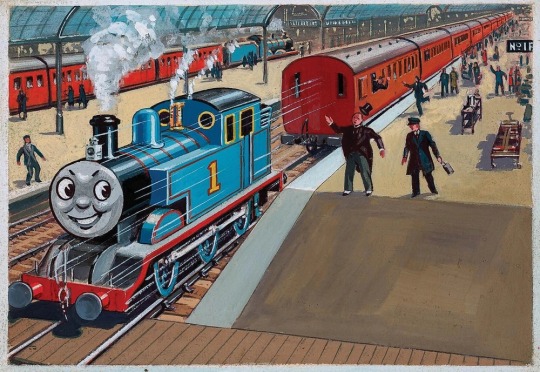

The Railway Series, however, would pick up a lot of the slack from this loss, as many of its earliest stories were in that same moral vein as traditional 'engine culture' stories, focusing on listening to elders, not stopping in tunnels, being patient, gentle with coaches, careful with trucks - it's all there. And I can see that being due to Edward teaching the Reverend many of these stories, in a bid to keep them from vanishing. And he would continue on, joined by other older engines like Skarloey, Rheneas and Toby, as the book series went on. Things like listening to advice and not acting recklessly pop up constantly - especially with Duncan, who Skarloey had to deal with.
It all gets worse when British Railways forms though. And this is where the 'railway rulebook', the attitudes of diesels and the doctrine of BR all come in to play. As the doctrine and official rulebook of British Railways portrays steam engines as inferior, weaker engines, the diesels are indoctrinated into believing it - and thus, they refuse to listen. Take Diesel for example, who believes that diesels can just arrive at a yard and 'improve it'. He is immediately foiled by some jammed breaks - something he may have learnt about from a story or a tale from a steam engine. But he never stopped to listen. And it's the same across the country, across the world in fact. As the successful diesel classes prove themselves to their managers, they are rolled out and steam engines are withdrawn - and with that, so is the culture they were the keepers of.

But this isn't quite the end of this 'engine culture' yet, because one group willing to listen to the steam engines are the 'failures'. Engines like BoCo and Derek would be very willing to listen to the engines that have tales that may just help them. Stories like how to best use sand in a storm, or how to conserve energy over the Settle-Carlisle route. And so even as steam dies, these 'failures' hold their culture, and try their best to preserve it, alongside the preserved engines. The Railway Series does too, such as in 'Stepney the Bluebell Engine', where sanding is explicitly mentioned. Another group that take in this engine culture is the GWR diesel-hydraulics, who grew up with GWR ideology, and thus would have been more willing to listen to their steam ancestors.

But these 'non-standard' engines were also quickly wiped out. And this leaves only a few pockets of engines who remember the old stories: the preserved engines, and the few Gen-1 diesels who did listen. By the end of the working lives of the Class 40s, the Deltics and the 'Peaks', they are the last engines who remember the old stories from the steam era working on British Railways, and when they are scrapped, the next generation grows up relearning everything.
Because the fact is that these stories held a major purpose, and the destruction of that culture means that every mistake every warned against is suddenly being made again, and again, and again. We notice this in the Railway Series, where Diesel, and Class 40, and D199 and even Bear all make very elementary mistakes that would have been warned against in these cultural stories - like taking care around trucks or looking out for the wind. And it only gets worse as this first generation are scrapped. Engines scramble to a standstill on leaves again, engines get trapped in floods, or lost in storms, or run through signals - and it's because the games, the songs, the stories, everything that would have prevented these accidents is lost.


It's not until these diesels reach preservation that they hear the stories remembered by the steam engines, and that's when they realise that... hey, maybe the ancestors were right after all.
The saddest part is that it's not only a global thing, but that it's still very much a problem on modern railways. The loss of 'engine culture' between the 1950s and the 1980s would have a domino effect that would still impact modern railways, as the even newer electric engines and multiple units face the same issues but with no prior knowledge.
The pictures in this post are not mine.
#fanfiction writer#thomas the tank engine#weirdowithaquill#railways#railway series#the railway series#ao3 stuff#very long post#long reads#british rail#british railways#engine culture#ttte lady#ttte proteus#ttte diesel#ttte class 40#ttte stepney#ttte analysis
126 notes
·
View notes
Text
☏ Masterlist ☏
Sonic the Hedgehog
SH Tails/Reader • SH Tails/bold yet shy!Reader • SH Tails/sleepy!Reader • SH Tails/psychopathic!Reader • SH Tails/hyper cuddly!Reader • SH Tails/adoring!Reader • SH Tails/fox!Reader • yandere SH Tails/yandere Reader • yandere SH Tails/sweetheart!Reader • Nine/unintelligent yet emotionally clever!Reader • yandere Nine/Reader • yandere Nine/human!Reader • yandere Nine/Reader Rivalry • yandere Nine/abducted!Reader • yandere Nine/sweet!seedrian!Reader • yandere Sails/Reader • Sails/traveler!Reader • yandere Mangey/Reader • Mangey/traveler!Reader • yandere WWMH Miles/Reader • yandere Kitsunami/Reader • Zor the Zeti/pregnant!Reader •
NSFW Headcanons --- Zails/female!Reader [eating you out] • Nine/female+GN!Reader [eating you out+make out sessions] •
A Once Innocent Act of Tenderness - yandere SH Tails/Reader [Community Label: Mature] • Representative of Power - SH Tails/Reader [!Smut!]
Achievement Through Appetite - Miles[Operation Crimson]/female!Reader [!Suggestive!]
It’s called Desperation, Dummy~ - Tails/Reader [!Suggestive!]
A Betrayal out of Nowhere - Zails/Reader [!Smut!]
Creepypasta
yandere Julius the Dressmaker/Reader • Julius the Dressmaker/Reader Affection •
Survival instinct didn’t make the cut - yandere Ticci Toby/Reader
Toilet-Bound Hanako-Kun
Hanako/Kou/Yashiro/Sakura/Reader who has a panic attack
Vocaloid
yandere Fukase/Reader • Fukase/Reader who lives under a rock
•#1 A State of Seduction - Fukase/Reader [!Smut!] #2 The Brattiest go Below - Fukase/Reader [!Smut!] • A Fall to Temptation - Fukase/Reader [!Smut!] •
Friday Night Funkin’
yandere Faker Sky/Reader • Faker Sky/Reader who likes to smooch her in her ‘mask off’ form • Miko/Tiktok addict!Reader
South Park // Hellpark
Hellpark Pip/sweetheart!childhood friend!Reader
So Wrong yet So Right - Hellpark Pip/Reader [!Suggestive!]
Happy Tree Friends
Flippy/sweetheart!Reader/Fliqpy
Fight Forwards Favour - Fliqpy/Reader
My Little Pony
yandere Changelings/human!Reader
Chikn nuggit
yandere Hawt Saus/Reader • yandere Fwench Fwy/biological child!Reader/yandere Iscream •
Popee the Performer
Popee/Reader
NSFW Headcanons --- yandere Popee/Reader who hate-flirts with him • yandere Eepop/Reader [stepping on him] •
Monster Hunter Stories
Dr.Manelger/assistant!Reader/Itsy-Bits
Hyoro reacts to fatally injuring his Darling
Lego Monkie Kid
Redson/male!Reader •
Disney
The Claim of an Operational Sin • Claude Frollo/female!Reader [!Suggestive!]
Misc.
yandere The Angel/Reader • Rio Ranger/Reader fluff alphabet 1/4 • Rio Ranger/Reader fluff alphabet 2/4 • Rio Ranger/Reader fluff alphabet 3/4 • Rio Ranger/Reader fluff alphabet 4/4 • Aoi/Reader/Miyuki • yandere Lucian Abbot/Reader •
Good Boy? More like... Gutter Boy • yandere Lucian Abbot/Reader [!Smut!]
Psych Ward of Partiality • Arc/Reader [!Suggestive!]
Heads or Tails for Granted • Rio Ranger/Reader [!Smut!]
Lost Chances Face Consequences • yandere Kennith Simmons/female!Reader
65 notes
·
View notes
Text
𝖃𝕴𝕴𝕴 𝕿𝖆𝖑𝖊𝖘 𝖋𝖗𝖔𝖒 𝕱𝖊𝖚𝖉𝖆𝖑 𝕭𝖔𝖍𝖊𝖒𝖎𝖆
𝔄𝔠𝔱 ℑ, 𝔰𝔠𝔢𝔫𝔢 𝔦𝔦i
Our story concludes - at least, this part of our story concludes - at the court of Prince Brandl, in a hidden half-forgotten hall nestled within the Castle grounds. In attendance, the Prince himself, his warlock and his necromancer; the veiled, masked, Ecaterina the Wise; Garinol Cappadocius, Abbot of St. Lawrence's; and our player characters, making their reports or ensuring that their messages were delivered.
And our session began with a flashback, because Brother Marsillius and Sister Alzbeta had met before! I encouraged @gwenynen-bach to take the Semblance of the Methuselah flaw, for my own reasons (tee hee!) that started to unfold with Alzbeta mistaking him for her own absentee sire. Dead ringer. 'Tis the beard. (I am also very impressed with @viatrixobscura's description of the sensations of finding oneself undead, excellent work there.) The Weave suggested that Alzbeta could trust this monk, that she would need him before her task was done, and thus she asked Marsillius to join her on her quest for holiness, insight and God's love. He consented, and we return thus to the present night...
Theodericus, desperate to make friends, overlooked Mariam's indirect sassing of Prince Brandl, and reached out to the Prince, taking his magnanimous hand to comfort Brandl for having not visited London and not stood in the presence of Mithras Himself. This was not a strategy designed to endear him to the Prince, but that boy is incapable of telling a lie, or even withholding an inconvenient truth. (Theodericus simps so hard for Mithras. It's unbelievable. There were real tears. Mariam is concerned about his well-being.)
In any case, Theodericus attempted to convince Prince Brandl that all this tension with the Nosferatu was a misunderstanding, that his previous emissary had an accident, or was rude, and that a higher power had decreed the Jewish elder could keep his own domain. Prince Brandl gave a short speech on the significance of the First Tradition, that of Covenant, regarding his own authority being derived from Caine and thus from God.
While this was going on, Marsillius was struck with a vision; a sensation as of something great and cold and dead moving through and beneath the earth, of great citrine eyes watching from behind the torchlight, blinking, blinking.
Another flashback: this time to Alzbeta and Theodericus discussing the ill-formed vibes within Josefov, as though something unfortunate was on the horizon, and should Alzbeta trust the Weave's warning? Theodericus, adamant that the gift of foresight is a gift of Caine, advised her yes - and inadvertently outed himself as a Cainite Heretic into the bargain. Whoopsie-doodles.
Alzbeta thus explained her forebodings to the Prince's party, and Ardan the warlock opined this was no unusual matter; it was nearly midsummer, Kupala Night was fast approaching, and if there was devilry to be done it would be done then. Marsillius, racking his brain to the tune of seven successes, not only identified Kupala Night as a celebration but pinpointed where it would be celebrated and by whom, and whom was coincidentally not represented at this court. Tzimisce, then.
One more flashback, to Alzbeta's first court, when she was taken before the Prince to account for her existence, and he displayed his knowledge of Blood Sorcery, identifying her as "of the Clan of the Moon" and electing to preserve her life and her insight for the good of the city.
Alzbeta and Marsillius compared visions, and perspectives on divinity. It was a lovely heartwarming moment in which Marsillius was deeply awkward and both these Kindred of the cloth were clearly compromising their vows about each other, fnar fnar.
As Prince Brandl and Ecaterna argued about the significance of this happening and the peril in which the Old Town might be placed and the recent struggle for control of the Kingdom, Ardan took the opportunity to scry some souls - specifically that of Mariam, the unexpected guest from Josefov. She did not like this! @friends-of-beetlejuice is powerful and courageous and decided to initiate a social conflict despite not in fact playing a character with any of the really useful Skills for this practice; to be fair, rounds one and two went one for one, but the Warlock absolutely nailed her on the question "and do you think your message has been understood?"
Her only option: Success at a Cost. Mariam has bullied Ardan into silence in front of his fellow courtiers, but has gained the Adversary Flaw: the warlock will have his revenge. Tee hee. Tee hee.
At the end of our prologue, we have Ambitions set for the next story:
Mariam is concerned about the "something dark" that's coming for her people, but still mostly focused on what happened to Zachary the rabbi (which I've now determined: I was keeping my options open, depending on which way the players leaned during these early sessions)
Alzbeta is ready to learn more about Malkavians, and has been advised to begin her search in the Old Town (where we haven't been yet, but I'm hype to start the next session there)
Marsillius wants to cook the books, exploring the mysteries of Clan Tzimisce ("one does not simply walk into Vysherad")
Theodericus wants to visit the Mithraeum - he's feeling very rattled by all this religious disputation and wants to reconfirm exactly where he stands vis-a-vis gods and mystics and his Prince.
We thank you for reading, and hope you'll continue following these reports into Act II!
#dark ages vampire#vampire the dark ages#vtda#vampire the masquerade#vtm#session report#malkavian#hecata#ventrue#nosferatu#tzimisce#chronicle: xiii tales from feudal bohemia
8 notes
·
View notes
Photo



600-Year-Old English Gold Coin Found in Newfoundland
The discovery of a rare gold coin on the south coast of Newfoundland, Canada, may challenge traditional historical narratives about the timing of European contact in the region, as it predates explorer John Cabot's arrival on the island by at least 70 years.
In a press release last week, the Government of Newfoundland and Labrador said that the English coin was found during the summer of 2022 by Edward Hynes, a local amateur historian, who reported it to officials as required under the province's Historic Resources Act. The 600-year-old coin predates the first documented European contact with North America since the Vikings, in a region with a 9,000-year-old history of human settlement and rich Indigenous traditions.
After consultation with Paul Berry, a former curator of the Bank of Canada's Currency Museum, the coin was identified as a Henry VI quarter noble, minted in London between 1422 and 1427. In the 1400s, the coin would have represented a significant sum of money, valued at 1 shilling 8 pence, or around 81 Canadian dollars ($61) today.
Prior to this discovery, a coin minted in the 1490s and found in 2021 at the province's Cupids Cove Plantation Provincial Historic Site was considered the oldest English coin ever found in Canada.
As Berry says that the coin was likely out of circulation when it was lost, there is much speculation about exactly how the gold quarter noble coin made its way to Newfoundland and Labrador. The precise location of the discovery is being kept secret to discourage treasure hunters.
The discovery of the coin underscores the intriguing archaeological record in Newfoundland and Labrador, Canada's easternmost province. Stories of Viking arrival are contained in Icelandic sagas, citing visits by Leif Erikson over 1,000 years ago, and archaeological evidence of a Norse settlement, which was found in L'Anse aux Meadows, Newfoundland, and declared a Unesco World Heritage site in 1978.
Other unconfirmed accounts of European contact include tales from England's Channel Islands about a ship being blown off course in the late 15th century into a strange land full of fish; historical Portuguese maps depicting Terra do Bacalhau (or, the land of codfish); and the "Voyage of Saint Brendan," a legendary account of an early 6th-century sea voyage by an Irish abbot.
In 1583, Newfoundland became England's first possession in North America and the establishment of fishing operations on the outer coastline of the island cut off access to traditional food sources for the indigenous population.
"There's been some knowledge of a pre-16th century European presence here for a while, you know, excluding Norse and so on," Brake told CBC. "The possibility of perhaps a pre-16th century occupation would be pretty amazing and highly significant in this part of the world."
#600-Year-Old English Gold Coin Found in Newfoundland#Edward Hynes#metal detector#metal detecting finds#archeology#archeolgst#gold#gold coin#Henry VI quarter noble#treasure#ancient artifacts#history#history news#ancient history#ancient culture#ancient civilizations
196 notes
·
View notes
Text
Demon William Easton and Vampire Grace Le Domas Headcanons
Here's a bit of background info before anything else: I came up with this idea after watching Abigail the first time and saw that there were easter eggs connecting it to Ready or Not, which is one of my all-time favorite horror films. Thus the brainstorm of Grace turning into a vampire was born. With William, it was a little trickier to decide what I wanted him to be, as I already had an AU where Ari happens to be a werewolf. I’d been watching a lot of Black Butler, so a demon was what I landed on.
Ultimately I would love to explore these concepts in fic form, but currently I can’t quite find a plot. Granted that’s not always necessary as my Willace fics are more character and relationship studies, but it feels like with a larger universe at my fingertips I should put some effort in. So feel free to ask me things about these two or suggest ideas, maybe it’ll get my mind whirling.

Demon William Easton
Most of my AUs are dependent on William surviving his test, but this is the one exception. Being resurrected as a demon relies on Will failing and being approached by a higher power, in this case the mysterious Le Bail.
After William dies, he is offered a choice of either moving on or coming back as something that isn’t human. It is due to his heartbreak and anger over what occurred that he chose to become a demon.
His humanity and compassion are not completely wiped out, but he is a darker individual than before.
William’s blood is acidic, and he can control the potency. Though there is a part of him that would love to melt something off of Brent Abbot, he keeps a wide berth from the people in his past. Sadly, this includes his sister, Pamela, but he checks in on her in what ways that he can.
When Le Bail transformed Will into a demon, he also created a soul bond to Grace, unbeknownst to them until they cross paths later on. It results in a bit of understandable awkwardness at first.
Demon William is stronger, faster, and capable of wielding magic, though he did have to learn demonic spells and incantations. Despite his deceptively lean frame, he’s fully capable of ripping a werewolf in two. He’s naturally, fiercely intelligent to boot, and extremely loyal to those he cares about.
As he is a supernatural being now, Will is more elegant and sensual by default. This is represented not only in how he carries himself, but how he chooses to dress. He prefers a tailored suit, but forgoes a tie, leaving his collar unbuttoned on purpose. Not to put too fine a point on it but the man is incredibly hot. If you mixed Ari Tasarov and David Sandstrom together, you basically have Demon William.
His absolutely gorgeous blue eyes remain unless he needs to wield his full power. Then they turn crimson.
His skill with formulas and wording play easily into him having to create contracts in this new form, which is why he essentially created a private insurance company dedicated to protecting the supernatural. He also has his hobbies to keep him occupied, such as chess and reading (he’s a giant bookworm).
His stamina is impressive enough that he can keep up with Grace and her bloodlust easily. Their connection is intense due to their soul bond, so you couldn’t ask for a better power couple whether they are battling or indulging in their passion for one another.
Vampire Grace Le Domas
As she wasn’t bitten, but transformed by an otherworldly source, the vampire curse took some time to manifest.
Her symptoms began as a hunger, first for raw meat, then for blood.
While she is sensitive to sunlight it won’t kill her. It’s more like an intense allergy if she spends too much time in it.
Grace is understandably horrified when she realizes what she’s becoming and she does not hesitate to direct her anger at Le Bail, who she has been able to communicate with since the disaster that was her wedding night.
Le Bail is the one who steers her on the path to find William, essentially guiding her to her soul mate. However, their relationship and how it evolves is dependent on mutual decisions (there is no lack of agency on either party here). When she agrees to their contract, it is represented in a pair of rings that they wear, which are similar to wedding or claddagh rings.
Grace’s goal after teaming up with William is to protect the innocents, particularly from nastier demons and otherworldly forces. Luckily he’s completely on board with this since he harbors similar feelings to hers.
The fact that both Grace and William survived “games” in their past is why they don’t care for such things in the present, barring chess (at least on Will’s part, he has to teach Grace the finer points of it). It’s also what causes them to bond and form first a friendship, and then a romance.
Her vampiric abilities include strength, flying, enhanced healing and shapeshifting. She’s also particularly vicious if she hasn’t fed, so she keeps a steady blood supply on hand. Her personal favorite is type A.
Because of the nature of William’s blood, Grace is extremely hesitant to feed from him. Eventually he all but demands it of her, and it turns out that she’s not affected by the acidity.
Grace is feisty and playful, which balances well with William’s more serious nature (though he certainly has his moments). One of her favorite outfits to wear while on her quest is a more functional take on her wedding dress with a black leather jacket.
#willace#william easton x grace le domas#headcanons#mine#mrsreginagold#peter outerbridge#sometimes a crack ship ends up becoming serious and then things like this happen
10 notes
·
View notes
Text


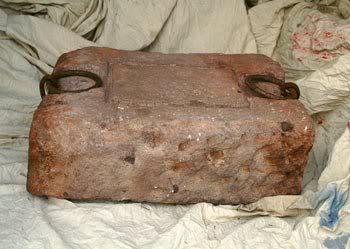
On 11th of April 1951 The Stone of Scone, the stone upon which Scottish monarchs were traditionally crowned, was found on the site of the altar of Arbroath Abbey.
It’s always good to get details from the era in posts, this is a contemporary newspaper report of the event.
Three and a half months after its removal from the Coronation Chair in Westminster Abbey early on Christmas morning, the Stone of Scone was to-day deposited in Arbroath Abbey in Scotland. Three men drove up to the abbey and carried the stone, which was draped in a St. Andrew’s flag along the main aisle before laying it at the high altar, on the grave of King William the Lion of Scotland.
The stone was handed over to Mr. James Wishart, custodian of the abbey, who remained with it until a detachment from Angus County Police took possession. Afterwards it was removed to Forfar, where it lay in a locked cell at police headquarters for the night. On top of the stone two unsigned letters were left: one addressed to the King and the other to the General Assembly of the Church of Scotland as “successor to the Abbots of Scone.”
The letter to the King read:
“Unto his Majesty King George VI, the address of his Majesty’s Scottish subjects who removed the Stone of Destiny from Westminster Abbey and have since retained it in Scotland, humbly showeth.
"That in their actions they, as loyal subjects, have intended no indignity or injury to his Majesty or to the Royal Family.
"That they have been inspired in all they have done by their deep love of his Majesty’s realm of Scotland and by their desire to compel the attention of his Majesty’s Minister to the widely expressed demand of Scottish people for a measure of self-government.
"That in removing the Stone of Destiny they were restoring to the people of Scotland the most ancient and most honourable part of the Scottish regalia, which for many centuries was venerated as the palladium of their liberty and which in 1296 was violently pillaged from Scotland in the false hope that it would be the symbol of their humiliation and conquest.
"That the stone was kept in Westminster Abbey in defiance of a royal command and despite the promise of its return to Scotland.
"That by no other means than the forceful removal of the stone from Westminster Abbey was it possible even to secure discussion as to its rightful resting place.
"That it is the earnest hope of his Majesty’s Scottish people that arrangements for the proper disposition of the stone may now be made after consultation with the General Assembly of the Church of Scotland who as successors of the Abbots of Scone are its natural guardians.
"That it is the earnest prayer of his Majesty’s loyal subjects who have served his Majesty both in peace and war that the blessing of Almighty God be with the King and all his peoples so that in peace they may enjoy the freedom which sustains the loyalty of affection rather than the obedience of servility. God save the King.”
The letter which was addressed to the General Assembly of the Church of Scotland asked that the representatives of the Church should “speak for the whole people and arrange with the public authorities in England that the Stone of Destiny will be retained in Scotland.”
wo Arbroath town councillors, Mr. D.A. Gardner and Mr. F.W.A. Thornton, both of whom are prominently associated with the Scottish Convention movement, were waiting at the entrance to the abbey when the three men arrived. Mr. Thornton helped them to carry the stone in, and Mr. Gardner went to Arbroath police station to inform the police that the stone was lying in the abbey.
Mr. Wishart, who is 63 and has been custodian at the abbey for nine years, told a reporter that the men got out of the car and started to take a heavy object from the back seat. Councillor Gardner came up and said: “Is that the Stone of Destiny you have?”
Mr. Wishart said that Mr. Thornton and three men carried the stone on a wooden litter up what used to be the nave of the abbey between the ruins of the pillars. “They laid it at the three stones which marked the site of the high altar. They carried the stone in a reverent manner, their heads were uncovered, and it was a solemn and impressive little ceremony. The men shook hands with me and wished me the best of luck and then went. As soon as I knew that the Stone of Destiny had been placed in my charge I locked the gates.”
Mr. Wishart said that the three men were “young well set-up lads,” but apart from that he was unable to give a description of them. The car was big and dark-coloured, but he did not note the registration number. “I have always told visitors that one day the Stone of Destiny would come to this historic spot,” he said, “and I am glad that my words have come true.”
On 13 April the Stone was returned to Westminster Abbey.
A wee bit history behind the stone, the first Scottish monarch to be crowned atop the stone in the 11th century, with John Balliol the last King to use the stone on Scottish soil in 1292.
In 1296, the stone was captured by Edward I as spoils of war and taken to Westminster Abbey. On St Andrews Day 1996, the Stone of Destiny was legally returned to Scotland with a ceremony and celebration befitting its status. Since that day, it has remained within the confines of Edinburgh Castle alongside the Honours of Scotland. Thousands lined the Royal Mile to see the stone escorted from the Palace of Holyrood House to the castle.
67 notes
·
View notes
Note
Do all/most of JTTW’s monsters of the week represent specific obstacles during the journey to enlightenment? Like, I heard the the Six Eared Macaque represents a dark side to/illusionary/second mind, but what about some of the other villains?
I can't say for sure if there are other allegories that are quite as clear cut as the facing-your-own-doppelganger/evil self trope but I do like to think that each demon/trail has its own lesson in its own ways.
There are A LOT of demons (or antagonists in general) in JTTW, I tried to make a list about each one and how they were subdued (it's not complete and I'm afraid I've been lazy) to try to see how each demon fit into the story. Of course, I'm sure that each demon could have an allegory within their battles, as there is demons that have underlying meanings.
Bull Demon King - Wukong fighting someone he has a past with, being forced to face that past and having to cut ties with his family
Yellow Robe Demon - The demon that became a demon for the sake of following his love, perhaps paralleling how Wukong came back due to his own loyalty to his pilgrimage.
The Old Abbot - suppose to be a symbol for other monks to follow but instead gave in to his own greed, paralleling Tang Sanzang's own humbleness.
These are all my personal takes, there isn't really any discussion about them and these are like only the first few demons. I'm not saying that each demon DOES have a lesson and maybe I will do a more in-depth look once I have time and re-read JTTW.
But until then maybe it is best to say it's left to interpretation and see what you think for yourself!
This is an attempt me making an easy to read/access JTTW demon list.
But I'll have to keep in mind what the other might represent symbolically throughout the journey! Thanks for asking that!
87 notes
·
View notes
Text

The Harrowing of Hell from the Winchester Psalter (Winchester, Priory of St Swithun, c 1150 CE): An angel locking the door of Hell. Hell is represented as a great mouth within which are human beings and devils.
British Library, London, MS Nero C IV, f. 39r
The book also includes a Calendar, which provides evidence as to its origin. Saints of particular relevance to Winchester are included, among them Bishops Æthelwold (d. 984) and Brinstan (d. 934), and saints buried or with shrines there, such as Eadburh (d. c. 951), a Benedictine nun and daughter of Edward the Elder, and Grimbald (d. 901?), by tradition the co-founder of New Minster (later Hyde Abbey). The Calendar also includes two abbots of Cluny in Burgundy, Sts Hugh (d. 1109) and Mailous (d. 994).
The bishop of Winchester throughout the middle of the 12th century was King Stephen’s younger brother, Henry of Blois (r. 1139–71), who had been educated at Cluny. Henry was one of the richest men in Europe and a known art and relic collector. When appointed to the see of Winchester, he refused to relinquish the profitable abbacy of Glastonbury, which he held concurrently with Winchester until his death. The Cluniac references, Cathedral-specific prayer and Henry’s great wealth make him a plausible patron for such a lavish book, even if its vernacular components and central focus on the Psalms in French suggests that he may have intended it as a gift for a layperson.
[Robert Scott Horton]
* * * *
“The gates of hell are open night and day;
Smooth the descent, and easy is the way:
But to return, and view the cheerful skies,
In this the task and mighty labor lies.”
― Virgil, The Aeneid
+
“They say that in the second before our death, each of us understands the real reason for our existence, and out of that moment, heaven or hell is born.”
― Paulo Coelho, Aleph
16 notes
·
View notes
Note
Sometimes I feel like we are all reliving the 1930s, hurtling uncontrollably toward the 1940s and to WWIII. I don't think I'm overreacting when I see what's happening in the US and Italy, to say nothing of Russian aggression in Ukraine. As a historian, can you give me any hope, any examples where events of that era could have taken a different turn and where current times could turn out differently? Sorry to dump my angst on you.
Welp. I've been thinking about this ask for a bit, and I'll try to see if I can say anything that makes sense and is both realistic and hopeful. So here goes.
First off, history is not "fixed." It's easy to look back and say "oh, it could only have ever gone that way," but that's not true. So yes, there are literally countless examples, even in the 1920s/30s period between the world wars, and in the wars themselves, where things could have gone differently. People could have made different choices or acted in different ways, things could have broken different ways, luck could have been bad instead of good, good instead of bad -- etc etc. It's just life, and it happened the way life does: messily, chaotically, accidentally, unpredictably, until it was over and eventually people started looking back at it and studying it to see what that was. But it wasn't predetermined to happen that way, and nothing is predetermined or utterly destined to happen now. Yes, there are a lot of unsettling historical parallels -- war, plague, economic unrest, social inequality, etc etc -- that really makes you wonder if all of human history is just repeating our same mistakes in 100-year cycles. I struggle with this feeling myself, especially since as a historian, I DO know so much about what has gone on and failed to work before, and it astonishes me, not in a good way, that it's still happening now.
That said: people are so used to thinking of the study of history as Finding Out What Happened In the Past, and believing that there is only one singular narrative of what "did" happen, which can be uncovered and confirmed by objective theory and universally agreed truth. This was a historiographic theory popularized by Leopold von Ranke, a 19th-century German historian, who was trying to make the writing of history more scientific and systematic and following the essential rules of natural sciences (as the Germans were doing with a lot of academic disciplines in the 19th century). This had its merits in making the practice of history more rigorous and well-researched, but it also completely discounts the fact that all of human experience, experienced by all humans everywhere, cannot POSSIBLY be objective, or agreed on a single perspective, or represented everywhere. History happened to everyone everywhere, in all times and places, even if it wasn't the things that a certain person felt like writing down for posterity. One of my favorite anecdotes is that of a monk keeping a regional chronicle of events -- I can't remember where, in France or possibly Germany in the early 11th century or thereabouts. Next to a famous date, where an emperor died or a pope was overthrown or something of the sort (apologies again that it's early and I can't remember that either), he wrote essentially, "Nothing much happened this year. My brother who was abbot died."
Anyway, that really just sums it up for me. This monk was living in the middle of major events that would interest later historians, but he didn't know that or see that at the time, and his interest in chronicling this year was to write that his brother, who was an abbot, died. He was experiencing history by living his life and commenting on the places he lived and the people who he knew. That is because history is the monk's brother dying, as much as the emperor being overthrown; it happened in these small personal moments, as well as these huge political things. We see things and patterns in hindsight that look much clearer and put together than they actually were, but it's just the collective sum of human experience, good and bad alike.
As I have always said, people are people, in all times and places, and that means there's always hope, and there's always love, and it's usually right. Let me leave you with an absolutely heart-shredding passage from John Clyn, a fourteenth-century Irish monk and chronicler who was writing in 1349, just as the Black Death was sweeping over his monastery and leaving him as the only survivor. Alone and probably already ill with plague himself, Clyn wrote:
"So that notable deeds should not perish with time, and be lost from the memory of future generations, I, seeing these many ills, and that the whole world encompassed by evil, waiting among the dead for death to come, have committed to writing what I have truly heard and examined; and so that the writing does not perish with the writer, or the work fail with the workman, I leave parchment for continuing the work, in case anyone should still be alive in the future and any son of Adam can escape this pestilence and continue the work thus begun."
And just. My God. Even as he is "waiting among the dead for death to come," Clyn the historian finishes his work. He has committed to writing down what happened for future generations, because he still believed that there would be one. He saw the whole world "encompassed by evil," but he left parchment for someone else to write more, because if anyone should be alive in the future and anyone escaped the plague, they would want to continue the work. Of living, and writing, and doing history, and trying again. And you know what? He was right. Sons of Adam (and daughters of Eve, and children of God) did escape the pestilence. Not everybody died. Society was changed and rebuilt and life went on. The work did not fail with the workman. The future came. And the future will come again, even in the darkest and most terrible of hours.
Hugs.
169 notes
·
View notes
Text
SAINTS&READING: WEDNESDAY, SEPTEMBER 4, 2024
august 22_september 4
MARTYR AGATHONICUS OF NICOMEDIA, AND THOSE WITH HIM, WHO SUFFERED UNDER MAXIMIAN (4th c.)

The Martyrs Agathonicus, Zoticus, Theoprepius, Acindynus, Severian, Zeno and others accepted death for Christ during the reign of the emperor Maximian (284-305).
The Martyr Agathonicus was descended from the illustrious lineage of the Hypasians, and he lived at Nicomedia. Well versed in Holy Scripture, he converted many pagans to Christ, including the most eminent member of the Senate (its “princeps” or leader). Comitus Eutolmius was sent to the Pontine (lower Black Sea) region, where he crucified the followers of the Christian Zoticus, who had refused to offer sacrifice to idols. He took Zoticus with him.
In Nicomedia, Eutolmius arrested the Martyr Agathonicus (together with the princeps), and also Theoprepius, Acindynus and Severian. After tortures, Eutolmius ordered that the martyrs be taken to Thrace for trial by the emperor.
But along the way, in the vicinity of Potama, the Martyrs Zoticus, Theoprepius and Acindynus were unable to proceed further behind the chariot of the governor because of wounds received during torture. Therefore, they were put to death. The Martyr Severian was put to death at Chalcedon, and the Martyr Agathonicus together with others was beheaded with the sword by order of the emperor, in Selymbria.
The relics of the Martyr Agathonicus were in a church named for him at Constantinople, and were seen in the year 1200 by the Russian pilgrim Anthony. And in the fourteenth century Philotheus, the archbishop of Selymbria, devoted an encomium to the Martyr Agathonicus.
VENEABLE ISAAC ( ANTIMONOV, THE "ELDER" OF OPTINA(1894)

Saint Isaac, in the assembly of Optina elders, represents a type of ascetic-builder. For 32 years, he headed Optina Monastery, devoting himself entirely to the monastery, taking care of the brethren, continuing to create that particular “Optina” spirit that his predecessors planted. He took over the management of the monastery after the death of Archimandrite Moses. He was abbot during the flourishing of the monastery—during the time of the Elder Ambrose, and his successors in eldership, Father Hilarion and Father Anatoly (the Elder). Under his leadership, the future Elders Joseph, Barsanuphy, and Anatoly (the Younger) grew and developed. Archimandrite Moses revived Optina Monastery after a period of desolation, and Father Isaac continued his work, consolidating the state of the monastery, while not sparing himself from hard labor for its improvement. Elders Macarius and Ambrose blessed him in the difficult obedience of superior, seeing the high spiritual qualities, prayerfulness, simplicity, and humility of Father Isaac, and from these the ability to take care of the organization of the monastery—both external and internal.
It may seem that the Elder Isaac, who carried the cross of superiorship, dwells, as it were, in the shadow of the elders who spiritually nurtured the monks and pilgrims of the monastery—Ambrose, Hilarion, and Anatoly. Little of his teachings and statements were saved, so there are no such detailed memories of him. But this is his special achievement—by carrying the heavy burden of economic affairs of the monastery, he served the brethren and pilgrims, revealing an amazing height of humility. Behind his simplicity is an amazing depth, integrity, and strength of spirit. The period of his superiorship was the best time in the life of Optina.
Antimonov Family
Ivan Ivanovich Antimonov (the name of Saint Isaac in the world) was born on May 31, 1810, and was descended from an eminent, wealthy merchant family of the city of Kursk. The Antimonovs had the title of honorary citizens. The patriarchal spirit reigned in the house of the Antimonovs; the way of life was built strictly in accordance with Church rules, and only respect towards elders and obedience to them were accepted. Thus, the skills of piety and obedience, which are so important for a monk, the future ascetic received in his own home.
The head of the house was Ivan's grandfather—Vasily Vasilyevich Antimonov. He was particularly zealous to attend divine services. His eldest son Ivan Vasilyevich had thirteen children from three marriages. Ivan Jr. was the last, fifth child from his first marriage with Anna Puzanov. Little Ivan was a favorite of his grandfather, who often took his grandson with him to the church. Vasily Vasilyevich visited the church every day—he went without fail to the Matins and Vespers services.
Ivan Vasilyevich inherited his father’s piety and love for the Church, according to his upbringing; his simplicity and good disposition towards people produced a favorable impression on everyone. A family story is preserved about Saint Isaac’s father’s journey to Kiev in 1809 to the elder, Hieromonk Parfeny, who greeted Ivan Vasilyevich with the words: “Blessed be the womb that gave birth to a monk.” In raising the young Ivan and other children, he adhered to strict rules but never allowed himself to be rude to the children. He did not raise his hands at them—although at that time this was common in merchant families. The children, while behaving respectfully towards their father, loved him at the same time.
The Antimonov family enjoyed universal respect in the city for impeccable honesty, true piety, and wide charity—they were generous donors for Church needs and helped the needy. In the house there was even a certain day of the week appointed in which alms were given to the poor.
It was in such an atmosphere that Ivan Ivanovich’s years of childhood and youth passed. Details about this period of his life do not survive, but it is known that he was distinguished by modesty and was fond of silence. At the same time, despite his reserved nature, Ivan was endowed with natural gaiety and wit; his presence always enlivened family gatherings.
Life in the World
Upon reaching mature age, Ivan Ivanovich began to help his father in trade affairs. He constantly had to deal with people, give orders, and conduct financial calculations. He knew how to find an approach to a man, and he won people over by his heartfelt kindness and sense of justice. He had the most beneficial influence on his subordinates; he forced them to end any habit of fraud, any attempts to act deceitfully. Immaculate honesty in business earned Ivan Ivanovich universal respect.
Although strict in his requirements, the venerable one never took offense. Such a case is known: one of his workers, a man of obstinate nature, because of the constant punishments that Ivan Ivanovich gave him for carelessness and audacity, decided in his mind to kill him. When this became known to him, Ivan Ivanovich forgave the worker and released him, not handing him over to the hands of justice... Continue reading


2 Corinthians 3:4-11
4 And we have such trust through Christ toward God. 5 Not that we are sufficient of ourselves to think of anything as being from ourselves, but our sufficiency is from God, 6 who also made us sufficient as ministers of the new covenant, not of the letter but of the Spirit; for the letter kills, but the Spirit gives life. 7 But if the ministry of death, written and engraved on stones, was glorious, so that the children of Israel could not look steadily at the face of Moses because of the glory of his countenance, which glory was passing away, 8 how will the ministry of the Spirit not be more glorious? 9 For if the ministry of condemnation had glory, the ministry of righteousness exceeds much more in glory. 10 For even what was made glorious had no glory in this respect, because of the glory that excels. 11 For if what is passing away was glorious, what remains is much more glorious.
Matthew 23:29-39
29 Woe to you, scribes and Pharisees, hypocrites! Because you build the tombs of the prophets and adorn the monuments of the righteous, 30 and say, 'If we had lived in the days of our fathers, we would not have been partakers with them in the blood of the prophets.' 31 Therefore, you are witnesses against yourselves that you are sons of those who murdered the prophets. 32 Fill up, then, the measure of your father's guilt. 33 Serpents, brood of vipers! How can you escape the condemnation of hell? 34 Therefore, indeed, I send you prophets, wise men, and scribes: some of them you will kill and crucify, and some of them you will scourge in your synagogues and persecute from city to city, 35 that on you may come all the righteous blood shed on the earth, from the blood of righteous Abel to the blood of Zechariah, son of Berechiah, whom you murdered between the temple and the altar. 36 Assuredly, I say to you, all these things will come upon this generation. 37 O Jerusalem, Jerusalem, the one who kills the prophets and stones those who are sent to her! How often I wanted to gather your children together, as a hen gathers her chicks under her wings, but you were not willing! 38 See! Your house is left to you desolate; 39 for I say to you, you shall see Me no more till you say, 'Blessed is He who comes in the name of the LORD!'
#orthodoxy#orthodoxchristianity#easternorthodoxchurch#originofchristianity#spirituality#holyscriptures#gospel#bible#wisdom#faith#saints
3 notes
·
View notes